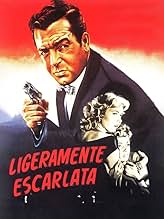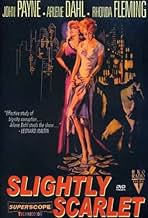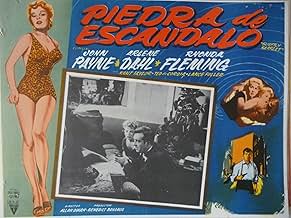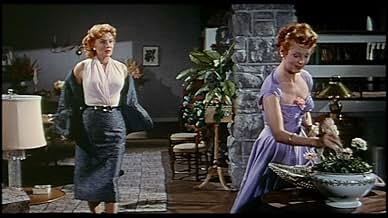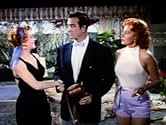CALIFICACIÓN DE IMDb
6.5/10
1.4 k
TU CALIFICACIÓN
Un liante ciudadano se involucra en el crimen organizado, la política corrupta de la ciudad y en sobornos a la vez que se enamora de la prometida del alcalde recién elegido.Un liante ciudadano se involucra en el crimen organizado, la política corrupta de la ciudad y en sobornos a la vez que se enamora de la prometida del alcalde recién elegido.Un liante ciudadano se involucra en el crimen organizado, la política corrupta de la ciudad y en sobornos a la vez que se enamora de la prometida del alcalde recién elegido.
- Dirección
- Guionistas
- Elenco
Fred Aldrich
- Policeman
- (sin créditos)
Murray Alper
- Hood
- (sin créditos)
Albert Cavens
- Man at Campaign Headquarters
- (sin créditos)
Ellen Corby
- Martha
- (sin créditos)
Paul Cristo
- Man at Campaign Headquarters
- (sin créditos)
Sam Flint
- Man at Campaign Headquarters
- (sin créditos)
Curt Furberg
- Man at Campaign Headquarters
- (sin créditos)
Rudy Germane
- Hood
- (sin créditos)
Frank Gerstle
- Dave Dietz
- (sin créditos)
Kenneth Gibson
- Man at Campaign Headquarters
- (sin créditos)
Roy Gordon
- General Norman B. Marlowe
- (sin créditos)
- Dirección
- Guionistas
- Todo el elenco y el equipo
- Producción, taquilla y más en IMDbPro
Opiniones destacadas
I am a trained psychotherapist, so when I watched "Slightly Scarlet", I saw things some others might not see. I mention this because one of the main characters, Dorothy (Arlene Dahl), is a psychological mess. She's a compulsive thief and a girl who craves excitement...all in the worst way. Today, she'd almost certainly be diagnosed with a Borderline Personality...meaning she possesses many qualities of a variety of personality disorders. Antisocial behavior, addictive behaviors and highly volatile mood swings...these are typical of such an individual...and Dorothy is very clearly dealing with these issues.
The film begins with Dorothy being released, yet again, from prison for shoplifting. Her enabling sister, June (Rhonda Fleming), tries her best to help Dorothy but it's clear Dorothy doesn't want saving....she's hell-bent on self destruction, good times and chasing men. Sadly, June is an idiot when it comes to Dorothy and she makes excuses for her wayward sister...and in many ways she enables and encourages Dorothy's actions. How far will all this go? And, how long will June put up with her sister's horrible behaviors? And, how long does Ben (John Payne) fit into all this?
This is a very exciting film that you'll either love or hate. Dorothy's behaviors and June's reactions to them can feel very frustrating....and I could see viewers hating BOTH sisters. But, if you can look past this, the film is fun to watch and worth your time. In some ways, it's like film noir...but the color cinematography make it hard to call it noir. Still, I enjoyed it despite its shortcomings.
The film begins with Dorothy being released, yet again, from prison for shoplifting. Her enabling sister, June (Rhonda Fleming), tries her best to help Dorothy but it's clear Dorothy doesn't want saving....she's hell-bent on self destruction, good times and chasing men. Sadly, June is an idiot when it comes to Dorothy and she makes excuses for her wayward sister...and in many ways she enables and encourages Dorothy's actions. How far will all this go? And, how long will June put up with her sister's horrible behaviors? And, how long does Ben (John Payne) fit into all this?
This is a very exciting film that you'll either love or hate. Dorothy's behaviors and June's reactions to them can feel very frustrating....and I could see viewers hating BOTH sisters. But, if you can look past this, the film is fun to watch and worth your time. In some ways, it's like film noir...but the color cinematography make it hard to call it noir. Still, I enjoyed it despite its shortcomings.
...with John Payne as an ambitious wheeler dealer working within a crime organization who manages to work his way to the top, while at the same time helping an honest politician running for mayor win that office. He then looks for favors.
Alan Dwan directed and John Alton photographed this production which some have labeled a Technicolor film noir. The cast is a good one. Aside from Payne, the film features Ted De Corsia as the head of the crime organization, Kent Taylor as the newly elected mayor and, in a stunning treat for the eyes, the only screen pairing of two of the most celebrated redheads of '50s films, Rhonda Fleming and Arlene Dahl.
Fleming is the secretary of the future mayor, living in a spacious home about half the size of an average castle and with a maid, to boot (some secretary!), and Dahl plays her sister, just released from prison, with a predilection towards kleptomania and men. Dahl's character is the more interesting of the two and the actress is effective in her role, bringing a flirtatious kittenish irresponsibility to many of her scenes. As the film progresses it becomes apparent that she suffers from a few mental health issues, as well.
But Rhonda - in tight shorts and a torpedo bra - competes with Dahl in her own special way, and I don't mean shorthand skills. Payne, perhaps a little overshadowed by the screen activity of the two lovely redheads, is still a credible tough guy, the film predictably leading up to his final confrontation with De Corsia and his mob.
Aside from the noteworthy contributions of Dahl and Fleming, Slightly Scarlet, based upon a novel by James M. Cain, may draw a bit of a surprise for some by the ambiguity of its ending.
Alan Dwan directed and John Alton photographed this production which some have labeled a Technicolor film noir. The cast is a good one. Aside from Payne, the film features Ted De Corsia as the head of the crime organization, Kent Taylor as the newly elected mayor and, in a stunning treat for the eyes, the only screen pairing of two of the most celebrated redheads of '50s films, Rhonda Fleming and Arlene Dahl.
Fleming is the secretary of the future mayor, living in a spacious home about half the size of an average castle and with a maid, to boot (some secretary!), and Dahl plays her sister, just released from prison, with a predilection towards kleptomania and men. Dahl's character is the more interesting of the two and the actress is effective in her role, bringing a flirtatious kittenish irresponsibility to many of her scenes. As the film progresses it becomes apparent that she suffers from a few mental health issues, as well.
But Rhonda - in tight shorts and a torpedo bra - competes with Dahl in her own special way, and I don't mean shorthand skills. Payne, perhaps a little overshadowed by the screen activity of the two lovely redheads, is still a credible tough guy, the film predictably leading up to his final confrontation with De Corsia and his mob.
Aside from the noteworthy contributions of Dahl and Fleming, Slightly Scarlet, based upon a novel by James M. Cain, may draw a bit of a surprise for some by the ambiguity of its ending.
Anyone remotely interested in cinematography and art direction should see this. John Alton, chiefly famous for his work in black and white, here switches to livid colour and achieves some of the most daring and moody effects ever known in colour films. This was a decade before 'flashing' the film became popular (a technique developed by Freddie Young, who told me all about it at the time he began the trend, with Lumet's 'Deadly Affair'). Everything here is so vivid, and the games played with colour in choice of sofas, walls, carpets, not to mention hair, are so intense, that the film is really chiefly of interest for all of that. Alton had to work only with variations in lighting, not with film processing possibilities. What he did is incredibly audacious, worth watching over and over just to study it. He has whole figures in shadow, and faces often are eclipsed by darkness in a bright room. It is really an incredibly dazzling display of virtuosity and genius. The two lead gals have matching hair, which plays well on the sets. Rhonda Fleming was a notorious strawberry blonde, and although I seem to recall that Arlene Dahl was really a normal blonde and presumably had her hair died to match Fleming's for this film, here they are very like the sisters they play indeed, with matching peachy hair and bright blue eyes. It is all a symphony of light and dark and colour combinations, like a modernist painting. The story is tepid, diluted from a James Cain novel about city corruption and crime. Arlene Dahl is not very convincing as a kleptomaniac siren who is supposed to be deeply psychologically disturbed (that part only comes out at the end, though we know about the thefts from the beginning, as the film begins with her coming out of prison). Rhonda Fleming swings her hefty bust around with confidence, and glares with her blue eyes at people as she challenges them, which with her fiery nature she does a lot. Into this mix comes a very seedy character played by John Payne, who by this time was really getting a little too old for such roles, nice fellow though he was. However, a sufficiently noirish tale ensues which is worth watching, though it is not a proper film noir, but merely has certain elements of that left, as the mid-1950s were asserting themselves, and people were getting more interested in Debbie Reynolds and Doris Day, and the War was a fading memory, and even the Korean War was passé by this time. Yes, things were changing, people were getting cheerier and more bourgeois by the minute, and gloom was no longer so popular, or must be relegated to horror films instead. Time to lighten up! So this is an interesting historical curiosity, a lingering shadow cast over the smiling face of a complacent Middle America which was just settling down to a nice long afternoon nap which would last until the sixties.
This movie showed Rhonda Fleming in a subdued part as a secretary to a town politico. She's one of my favorite actresses from the 50's, and was one of the most beautiful ever to grace the screen. John Payne was lucky enough to have a couple romantic scenes with her.
Back in the 50's, kissing scenes were far more romantic and tantalizing than today. Wish I could have bottled Rhonda Fleming!
Back in the 50's, kissing scenes were far more romantic and tantalizing than today. Wish I could have bottled Rhonda Fleming!
"You're not good; you're not bad. You're a chiseler, out for anything you can get."
So, says Solly Kaspar, crime boss of Bay City, of Ben Grace, the anti-hero of this story, adapted from James M. Cain's Love's Lovely Counterfeit. What holds our interest in this story is we're never quite sure what to make of Grace.
There's an upcoming election and crime boss Kasper does not want the reform candidate to win, so Kasper strongarms the newspaper publisher backing him, and in the process kills him.
Grace exposes Kasper, forcing Solly to flee to Mexico, and insuring the election of Frank Jansen, the reform candidate. He uses his influence with Jansen to get an honest police lieutenant friend of his appointed Chief of Police.
Good guy, right?
Then later in this movie he's seen giving orders to Solly's men, going over Solly's books, and positioning himself as Solly's successor. He calls his friend,the chief of police, and demands that his girlfriend's sister who was recently arrested be released without being charged, and so we begin to believe we've misjudged ol' Ben. He's just a hood, a little brighter than most, a little smoother than most, but in the end, no different from Solly Kasper.
Bad guy, right?
Well, we're not sure, because Grace isn't sure. Reform mayoral candidate, soon to be mayor, Frank Jansen has an assistant, June Lyons. On a 1 to 10 scale, Ms. Lyons, with her flaming red hair, and blazing headlights (think Good Girl art) is an 11. Rhonda Fleming never looked better, and Arlene Dahl as her sister, Dorothy Lyons, was equally stunning. But, back to Grace. He is falling for June, and June is a thoroughly decent girl, whose better nature seems to affect him.
In the end, however, Grace's schemes come to naught. Jansen who really is a reform candidate orders Dorothy be tried for her crimes. Solly Kasper returns wanting to take over as rackets boss, and Ben Grace is forced to run. Here's where we see his true character, when he scrounges as much of Solly's money as he can and invites his girlfriend to go on the run with him (she declines).
Solly Kasper was right all along. He really is just a chiseler, out for whatever he can get. Major disappointment, as in the end, Ben Grace disappoints not just his girlfriend, but the audience as well.
This is a beautifully photographed movie in full technicolor. The sets are a wonderful amalgam of art deco - rococo excess. Others here have pointed out how garish everything looked. I didn't find it so. I thought it was beautiful. Certainly, the eye candy was stunning. There aren't any two actresses today who could team as good girl - bad girl siblings the way Fleming and Dahl did. Maybe Julianne Moore and Debra Messing, but they wouldn't look as good. The movie's high marks for visual style are undermined by its low marks for aimless, meandering story. 6 out of 10.
So, says Solly Kaspar, crime boss of Bay City, of Ben Grace, the anti-hero of this story, adapted from James M. Cain's Love's Lovely Counterfeit. What holds our interest in this story is we're never quite sure what to make of Grace.
There's an upcoming election and crime boss Kasper does not want the reform candidate to win, so Kasper strongarms the newspaper publisher backing him, and in the process kills him.
Grace exposes Kasper, forcing Solly to flee to Mexico, and insuring the election of Frank Jansen, the reform candidate. He uses his influence with Jansen to get an honest police lieutenant friend of his appointed Chief of Police.
Good guy, right?
Then later in this movie he's seen giving orders to Solly's men, going over Solly's books, and positioning himself as Solly's successor. He calls his friend,the chief of police, and demands that his girlfriend's sister who was recently arrested be released without being charged, and so we begin to believe we've misjudged ol' Ben. He's just a hood, a little brighter than most, a little smoother than most, but in the end, no different from Solly Kasper.
Bad guy, right?
Well, we're not sure, because Grace isn't sure. Reform mayoral candidate, soon to be mayor, Frank Jansen has an assistant, June Lyons. On a 1 to 10 scale, Ms. Lyons, with her flaming red hair, and blazing headlights (think Good Girl art) is an 11. Rhonda Fleming never looked better, and Arlene Dahl as her sister, Dorothy Lyons, was equally stunning. But, back to Grace. He is falling for June, and June is a thoroughly decent girl, whose better nature seems to affect him.
In the end, however, Grace's schemes come to naught. Jansen who really is a reform candidate orders Dorothy be tried for her crimes. Solly Kasper returns wanting to take over as rackets boss, and Ben Grace is forced to run. Here's where we see his true character, when he scrounges as much of Solly's money as he can and invites his girlfriend to go on the run with him (she declines).
Solly Kasper was right all along. He really is just a chiseler, out for whatever he can get. Major disappointment, as in the end, Ben Grace disappoints not just his girlfriend, but the audience as well.
This is a beautifully photographed movie in full technicolor. The sets are a wonderful amalgam of art deco - rococo excess. Others here have pointed out how garish everything looked. I didn't find it so. I thought it was beautiful. Certainly, the eye candy was stunning. There aren't any two actresses today who could team as good girl - bad girl siblings the way Fleming and Dahl did. Maybe Julianne Moore and Debra Messing, but they wouldn't look as good. The movie's high marks for visual style are undermined by its low marks for aimless, meandering story. 6 out of 10.
¿Sabías que…?
- TriviaArlene Dahl offered to play cards with Rhonda Fleming to determine who would be the first on the poster. Dahl won the game, and in return demanded that Fleming be the first in the credits of the film. Fleming was very touched by this gesture and the two actresses became good friends.
- ErroresVery early in the film, just after Dorothy Lyons has been released from prison, Ben Grace is in police Lt. Dietz's office discussing her. The lieutenant is perusing Miss Lyons' criminal file which the viewer can briefly view. At the top of the document a spelling error displays her name as "Dorthy Lyons".
- Citas
Solly Caspar: Let's see if we can beat him down.
[after throwing a body out of an upper story window]
- ConexionesFeatured in Saving Cain: Robert Blees on 'Slightly Scarlet' (2009)
- Bandas sonorasFor He's A Jolly Good Fellow
(uncredited)
Traditional
Heard at the announcement of the election results
Selecciones populares
Inicia sesión para calificar y agrega a la lista de videos para obtener recomendaciones personalizadas
- How long is Slightly Scarlet?Con tecnología de Alexa
Detalles
- Fecha de lanzamiento
- País de origen
- Sitios oficiales
- Idioma
- También se conoce como
- Slightly Scarlet
- Locaciones de filmación
- Productoras
- Ver más créditos de la compañía en IMDbPro
- Tiempo de ejecución1 hora 39 minutos
- Relación de aspecto
- 2.00 : 1
Contribuir a esta página
Sugiere una edición o agrega el contenido que falta

Principales brechas de datos
By what name was Piedra de escándalo (1956) officially released in India in English?
Responda


